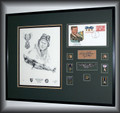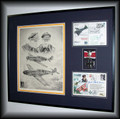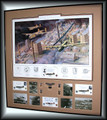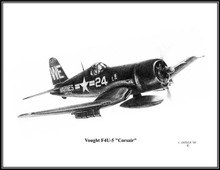 Loading... Please wait...
Loading... Please wait...Categories
Our Newsletter
- Home
- Combat Aircraft/Pencil Drawings ~ Free Shipping
- Vought F4U-5 "Corsair" ~ Free Shipping
Product Description
Print Size 8½ x 11 ----- Unlimited print edition
In 1945, the attention of the military aviation community turned to the turbo-jet-powered aircraft. The U.S. Navy, however, had decided they would keep the Corsair (and Grumman Bearcat) as their first-line fighter until the jet had been satisfactorily developed for carrier operations. During F4U-4 production, three were modified as prototypes for the F4U-5 model and were designated XF4U-5. On February 6, 1946, the Navy gave Chance Vought a letter-of-intent on the company?s proposal to build the F4U-5. Equipped with a new Pratt and Whitney engine and a sidewheel supercharger, it was a high-altitude fighter, designed to fight at 45,000 feet. The F4U-5 housed a R-2800-32W engine, developing approximately 2,300 horsepower which was 200 horsepower more than the ?C? engine used in the F4U-4. The engine also maintained greater power to a higher critical altitude than did its predecessor. Maximum speed was listed at 469 miles per hour at 26,800 feet, rate-of-climb was 3,780 feet/min at sea level. Other features included automatic controls for the supercharger, cowl flaps, intercooler doors, and oil cooler doors. The combat power system was automatic. Pilot comfort was emphasized to a high degree in a completely modernized cockpit. A redesigned cowl had air inlets at 4 o?clock and 8 o?clock. The entire outer-wing panels, for the first time on any Corsair, were metal covered. A substantial reduction in drag resulted. Spring tabs for use on the elevator and rudder controls reduced pilot effort as much as 40 percent. Guns and pitot tubes were electrically heated. The nose was dropped about 2 degrees to improve longitudinal stability and vision. Production began in 1946 with an order for 223. At that time, interest in night and all-weather fighters had grown to such an extent that the Navy ordered a large number of airplanes in the first group converted to night fighters (F4U-5N?s). This version is easily distinguished by its two-foot diameter radar dome in the leading edge of the right wing. The F4U-5NL was a winterized version of the F4U-5N airplane. It was basically the same as the F4U-5 airplane except that it included provisions for both night-fighter and cold weather operations. The winterization facilities are identified by the installation of de-ice boots on the wings and empennage, and de-ice shoes on the propeller blades. The F4U-5P was a long-range photo-reconnaissance airplane and was equipped with a unique rotating camera mount. Despite the 45,000-foot high-altitude capability, in actual use the F4U-5 would not require such an option. Its combat would be nearly all low-level, where the tremendous payload was eminently useful. When necessary, over 5000 pounds of ordnance could be carried on the twin underwing pylons and the centerline rack. And there were times when it was necessary. When the North Koreans invaded South Korea in June of 1950, the veteran Corsairs went back into combat. They were assigned the task of flying low-level attack and ground support missions. For post-war accomplishments of F4U, refer to ?F4U post-world war II Corsair operations.?
Warranty Information
null








